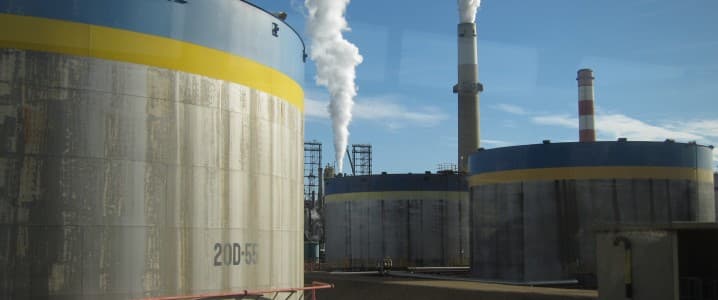Can Canada Boost Oil Production While Reducing Emissions?

Canada has recently increased its climate commitment by announcing a more ambitious mid-term target for 2030 on its path to net-zero by 2050. Still, the federal government expects crude oil production to continue growing and peak only a decade before 2050.
This glaring discrepancy signals that the industry, the province of Alberta, and the federal government should boost cooperation and increase investment and commitment in reducing greenhouse gas emissions, especially from the oil sands production, which is more carbon-intensive than most other ways to pump crude.
Environmental organizations are calling for a reduction of oil sands production as the easiest way to cut emissions and criticized the recent federal government climate pledges as not ambitious enough.
The oil and gas industry, for its part, is looking to cut emissions to clean up the image of the oil sands, whose high emissions prompted oil majors to divest assets in Canada just after the previous oil price crash in 2015-2016.
Last year, France’s Total booked US$8.1 billion impairments—of which US$7 billion in Canada’s oil sands—as it cut its short-term price expectations. Total identified the Canadian oil sands projects Fort Hills and Surmont as “stranded” assets in light of its pledges for carbon neutrality.
“The Biggest Industry In The Country”
The fact remains that the oil and gas industry is a major contributor to Canada’s economy, especially in the biggest oil-producing province of Alberta. Despite the layoffs during the 2020 oil price and demand collapse, the sector still supports hundreds of thousands of direct jobs. A transition to low-carbon energy must also come with a plan to relocate or reskill workers to ensure that the climate ambitions do not lead to higher unemployment.
Last year, Canada’s federal government was ready to help the industry, which it sees as crucial to its economy and economic recovery after the pandemic.
“This is the biggest industry in the country. It’s our biggest export, so there is a lot on the line for everybody,” Federal Natural Resources Minister Seamus O’Regan said in June.
Canada’s crude oil production is set to grow from 4.9 million barrels per day (bpd) in 2019 to 5.8million bpd in 2039, when crude output is expected to peak, according to estimates from the Canada Energy Regulator. This projection is under the so-called Evolving Scenario, which assumes increasing action on climate and low-carbon technologies development. Fossil fuels will still make up over 60 percent of Canada’s fuel mix in 2050, according to the estimate.
“Achieving net-zero GHG emissions by 2050 will require an accelerated pace of transition away from fossil fuels,” Canada Energy Regulator said.
Canada Strengthens Climate Action Pledges
Last month, Prime Minister Justin Trudeau announced that Canada would enhance its emissions reduction target under the Paris Agreement and now aims to cut those emissions by 40-45 percent below 2005 levels by 2030. The country also doubled down on its commitment to reach net-zero emissions by 2050.
The plan was criticized by environmentalists not only for falling short of the new U.S.cimate target of reducing carbon emissions by up to 52 percent by 2030, but also for its incompatibility with expectations that the oil sands industry would grow over the next nearly two decades.
“The Trudeau government has not come to grips with the fact that an expanding tar sands industry is fundamentally incompatible with both Canada’s aspirations for climate leadership or a global economy transitioning to clean forms of energy,”said Anthony Swift, Canada Project director at the Natural Resources Defense Council.
While strengthening emissions reduction targets, Canada’s government forecasts “a rapidly expanding tar sands industry that would export into a global market for oil that is fundamentally inconsistent with meaningful international action on climate,” Swift said.
Energy Industry Works To Slash Emissions, Produce Hydrogen
The energy industry, as well as Alberta’s government, recognize the need to significantly reduce greenhouse gas emissions if oil sands had the chance to still have “license to operate” in the energy transition.
The oil sands account for 12 percent of Canada’s total greenhouse gas emissions and 0.2 percent of global emissions, according to government data . Between 2000 and 2018, the emission intensity of oil sands operations dropped by around 36 percent due to technological and efficiency improvements, fewer venting emissions, and reductions in the percentage of crude bitumen being upgraded to synthetic crude oil, the federal government says.
“If we want the oil sands to be able to continue to grow production, we need to get emissions down,” Alberta’s energy minister Sonya Savage said at a conference last month, as carried by the Financial Times.
Alberta is betting on emissions-reduction efforts and its position as a major oil producer that is not associated with the price-fixing policies of OPEC+ as a more responsible producer of crude than countries like Saudi Arabia, Iraq, or Russia.
Alberta also looks to develop more carbon capture, utilization, and storage (CCUS) projects to abate emissions, as well as "blue "hydrogen" from its vast natural gas resources using CCUS technology.
Alberta “is well-positioned to become a world leader in hydrogen development, and is already one in CCUS,” Savage said last month.
“We don’t always see eye-to-eye with the federal government on energy,” Savage told FT. “But in hydrogen we do.”




